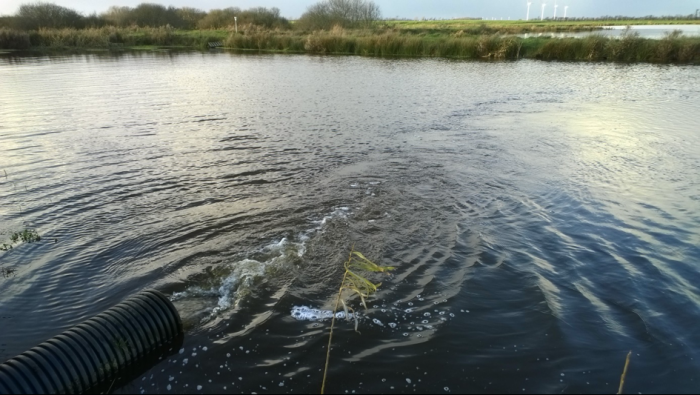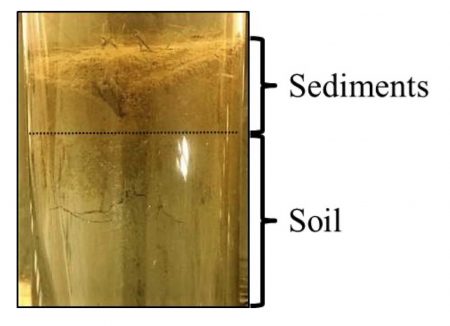
The expansion of agriculture worldwide has led to significant environmental problems associated with nutrients leaching and pollution of surface waters, which often results in eutrophication and degradation of water resources (Figure 1).

Figure 1. Problem associated with nutrients leaching from agricultural fields to surface waters downstream via different water runoff pathways, potentially causing eutrophication (Mendes, 2018a).
In Denmark, the expansion of agriculture was accompanied by intensive drainage of waterlogged areas, such as wetlands and peatlands, which naturally reduce the nutrient load from lands upstream through the sedimentation of particle-bound nutrients and biogeochemical processes before the discharge reaches surface waters downstream. This event reduced considerably the capacity of the land to control the loss and leaching of nutrients from agricultural fields. Moreover, Danish agricultural areas are highly drained (>50%), which speed up the nutrients transport to coastal and inland waters in comparison to other water runoff pathways.
In Denmark, surface-flow constructed wetlands are recognized as a mean to reduce the nitrogen loads by increasing the hydraulic residence time and allowing denitrification to occur (Figure 2). Two new studies, however, assessed the potential of these systems as phosphorus (P) sinks (Mendes et al., 2018b, 2018c). Prior to the studies, it was questionable whether P retention in these systems would be significant and/or consistent, considering that performance can be rather variable in systems receiving event-driven drainage discharge, according to previous studies. Moreover, the geochemical stability of the P retained in soil/sediments is generally uncertain and controlled by the availability of sorption sites. An earlier study had shown that lowland anoxic and iron-rich soils in Denmark tended to release P owing to reduction of ferric iron to ferrous iron (Forsmann and Kjaergaard, 2014). In addition, preliminary results demonstrated that the soil of the investigated wetlands was quite reduced, meaning that dissolution of P bound to redox-sensitive iron forms and release to the water column were expected.

Figure 2. A surface-flow constructed wetland receiving discharge water from tile-drained agricultural fields, in order to treat and reduce the nutrient load. Inlet pipe in the lower left corner. Credit: Lipe R. D. Mendes, Aarhus University.
To properly address the research questions, three surface-flow constructed wetlands with similar design, but receiving variable P load and dominant P form (particulate or dissolved), as well as located in different geological regions, were selected and systematically monitored (Figure 3). The wetlands consist of a sedimentation pond (1 m deep), followed by a basin with intercalating zones, where three are deep (1 m) and two are shallow (0.3 m). The area of these systems represents 1% of the catchment area.

Figure 3. The surface-flow constructed wetlands selected in the studies of Mendes et al. (2018b, 2018c). Note the first treatment stage consisting of a sedimentation pond at the inlet and the two shallow zones (0.3 m) with emergent vegetation between the deep zones (1 m). Image republished with permission from Elsevier from https://linkinghub.elsevier.com/retrieve/pii/S0925857418301836 and https://doi.org/10.1016/j.geoderma.2018.06.015.
First, the study found that the wetlands worked as P sinks (0.3-10.5 g m−2 yr−1) during the three-year monitoring period. The P load explained 52-72% of the variation in P retention rate, i.e., it was a major explanatory variable, which agreed with previous studies. However, the P load had little effect on the P retention efficiency (%), whose variation was partly attributed to the dominant P form–particulate forms are more easily retained through sedimentation in the upper sediments than dissolved forms–and to the inputs of iron (the dominant P sorbent in the study) in relation to P. Therefore, the study concluded that P retention efficiency was likely associated to the geochemical stability of the P retained.
Despite the initial belief that P stability would be compromised by the reduced soil and potential release of iron-bound P, the P retention efficiency was still representative (41-51%). These findings led to a second study (Mendes et al., 2018c), which investigated the P retention mechanisms and what ensures P stability in the soil/sediments (Figure 4). The experimental setup included analysis of soil/sediments geochemistry, redox dynamics and P concentration in the water in different points across the wetlands.

Figure 4. A core sample showing the deposited sediments (brown)–normally a major phosphorus pool–and the wetland soil below (grey) (Mendes, 2018a).
The new findings demonstrated that P was mainly retained in the sediments associated with iron. Moreover, despite the continuous loading of P, the deposited sediments presented generally a high P sorption capacity and availability of iron to P, which decrease the likelihood of P release to the water column, according to Forsmann and Kjaergaard (2014). But the question in regards to the stability of the iron-bound P still remained, given the consistent soil reducing conditions. Measurements of dissolved oxygen concentration near the sediment-water interface demonstrated clear annual variations, but yet predominantly aerobic conditions. This supported the hypothesis that any release of iron-bound P from the reduced soils would be offset by the aerobic conditions at the sediment-water interface, which would favour the binding of P to iron, followed by precipitation to the top sediments. Negative significant correlations (p ≤ 0.05) between dissolved reactive P concentration in the water column and dissolved oxygen concentration near the sediment-water interface also supported this hypothesis.
The studies above suggested that the efficiency of surface-flow constructed wetlands as P sinks is strongly connected to the inputs of P sorbents (e.g., iron, aluminium and manganese) in relation to the P load in the drainage discharge, and to the redox conditions near the sediment-water interface. Thus, high inputs of P sorbents and the prevalence of aerobic conditions would support availability of P sorption sites in the deposited sediments, and the stability of P bound to redox-sensitive iron forms, respectively, thus prolonging the system lifetime. These studies also highlighted the importance of a sedimentation pond as the first treatment stage, mainly in wetlands receiving a large load of P in the particulate form, as most of the P retention may occur there in this case. Thus, maintenance operations could particularly target the excavation of the excess deposited sediments and accumulated P in the sedimentation pond, in order to slow down P saturation in the system and consequently prolong its lifetime.
The experiments and findings are described in the articles entitled Phosphorus retention in surface-flow constructed wetlands targeting agricultural drainage water, and Phosphorus accumulation and stability in sediments of surface-flow constructed wetlands, published in the journals Ecological Engineering and Geoderma, respectively. The works were conducted by Lipe Renato Dantas Mendes, Bo Vangsø Iversen and Charlotte Kjaergaard from Aarhus University, and Karin Tonderski from Linköping University.
The research projects were funded by the Danish Strategic Research Council, GUDP and CAPES Foundation.
*Revised on March 7, 2020.









